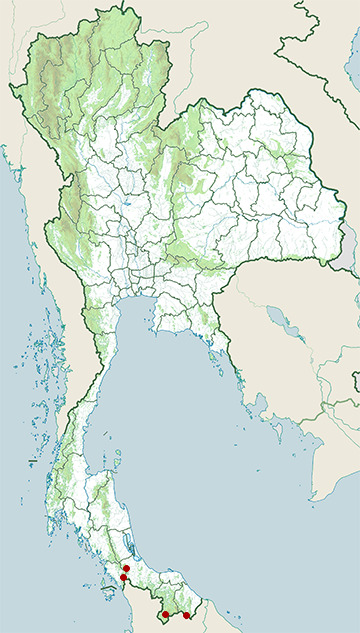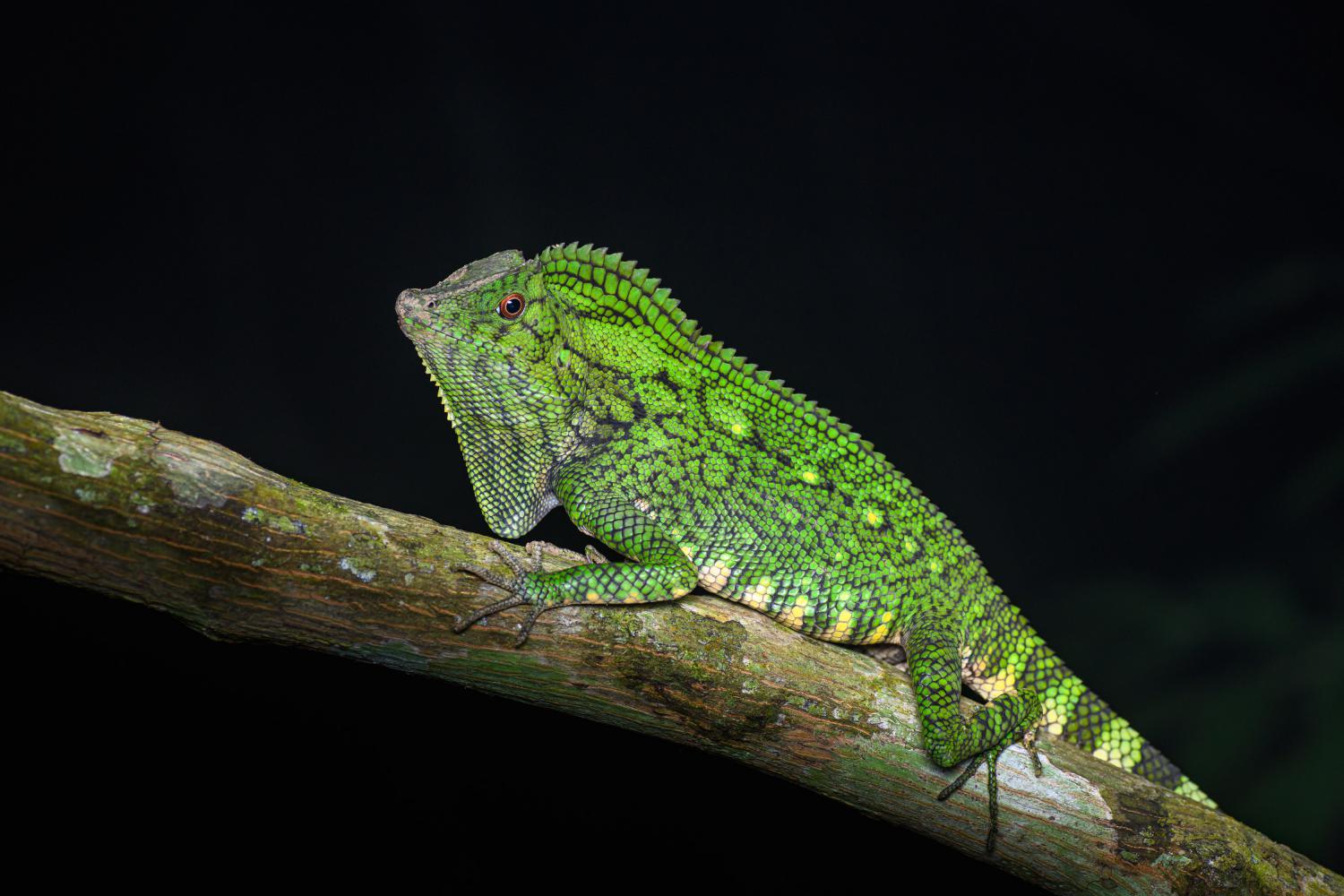Species of Thailand
Abbott's crested lizard
Gonocephalus abbotti
Doris Mable Cochran, 1922
In Thai: กิ้งก่าดงคิ้วสัน
Abbott's crested lizard (Gonocephalus abbotti) is a species of lizard in the Agamidae family. It is endemic to Thailand.
Etymology
Both the specific name, abbotti, and the common name are in honor of American naturalist William Louis Abbott.
Anatomy
Abbott's crested lizard is about 12 cm in total length (including tail). The most distinctive anatomical features are the triangular bony crest on the face and the upturned nose. The colors of the dragon range from tan to green with light and dark dots on the body. The most common color is an olive shade of green. Sometimes, G. abbotti species have blue eyes. The dragon’s structure is compressed and sickle shaped. Its limbs are strong and clawed. It is designed well for catching prey, digging, and climbing. It has exceptional eyesight with small eye openings. The body scales are small. The tail is strong, but it does not grow back if it is broken and can break in defense from predators. The crest is complete from head to tail and remains an additional distinctive feature (Cochran, 1922; Kaplan, 2012). The throat pouch is also more developed in males (Dring, 1979, pp. 875–879). (Kaplan, 2012).
There are two other species that closely resemble G. abbotti including G. doriae and G. chamaeleontinus. In fact, Denzer and Mathey (1991) pointed out in a case study that G. chamaeleontinus was mistaken for G. abbotti (p. 310). Unlike G. chamaeleontinus, G. abbotti’s initial crest scales are smooth and lack spikes. G. chamaeleontinus has larger scales on the side of the body. G. doriae holds an even closer resemblance, sometimes being considered a subspecies of G. abbotti. The main difference is that G. abbotti has a lower dorsal crest in the neck area (Cochran, 1922).
Reproduction and Gender
Particular information concerning reproduction of G. abbotti is scarce. Gonocephalus dragons in general are seldom bred in captivity. The majority of the dragons are caught in the wild. Most of the Gonocephalus species can breed year around and are also considered territorial lizards. Therefore, it is recommended to only have one or a pair if kept as a pet. They are egg laying lizards producing approximately one to seven eggs. The better condition the female is in, the more eggs she can lay. They reproduce sexually and reach sexual maturity from the ages of two to three. It is typical in Gonocephalus that the male is larger than the female. Also, the male can be reddish-brown to green, whereas the females and juveniles are typically green (Langerwerf, 2006, pp. 105–109).
Human Interaction, Pet Care, and Disease
Gonocephalus abbotti’s experience interacting with humans has been both positive and negative. The location of the dragon plays a part on the influence. The Thailand and Malaysia regions are subject to farming and the clearing of rainforest timber to acquire more farm land. The end product can result in the destruction of habitats of reptiles and lizards, including the angle-head. Many exotic lizards and reptiles are also hunted and sold as pets affecting the general diversity of rainforest organisms. Environmental degradation is an issue for the angle-head along with many other rainforest species (Bain, & Hurley, 2011). The Gonocephalus abbotti currently does not appear on the red list but it does appear in the catalog of life (“Catalogue of life: Indexing the worlds known species, ”2012). The angle head does not appear on the red list due to the lack of data.
The dragon can be a pet. Although lizards in general do not like being handled, they can tolerate human contact as a pet. If a dragon is being handled, it is recommended to handle them sparingly and for short amounts of time. Over handling can stress the dragon and can cause sickness. It is also important to be aware of lizard parasites. Every time a dragon is handled parasites are transferred from human to lizard and vice versa (Langerwerf, 2006, pp. 51–57).
The angle-head is a shy and an excitable dragon; therefore, a spacious pen is recommended to reduce stress and make them feel more at home (Langerwerf, 2006, p. 107). In fact, the environmental set up for the dragon is imperative to maintain a healthy dragon such as G. abbotti. The dragon should have an environment that provides a place to obtain warmth and bask. An environment that lacks this feature may accumulate an overabundance of moisture. This can result in blisters. On the other hand, if the environment is too dry the dragon may acquire a shedding problem called dysecdysis. The problem consists of incomplete shedding in areas such as the toes and the tip of the tail. An ideal temperature for a dragon enclosure ranges from 75 to 80 degrees Fahrenheit with a place to bask and stay moist. A temperature that is too high can cause heat stroke and or death. (Langerwerf, 2006, pp. 14, 52-53).
Addition issues that can occur in tame dragons are vitamin A deficiency and metabolic bone disease. Vitamin A deficiency is the shortage of vitamin A or carotenes. The dragon usually obtains vitamin A through the consumption of leafy greens and insects. This deficiency is found typically in tame dragons, since wild dragons have a surplus of greens and insects to eats. The lack of vitamin A can increase the parasitic issues, weakening the immune system, and can lead to the death of the dragon if the diet imbalance is not corrected. The metabolic bone disease is a product of lack of UVB light and calcium. Natural light gives off vitamin D3. This vitamin is vital to break down the calcium the dragon consumes, enhancing the importance of light. The disease can cause soft bones and muscle cramping (Langerwerf, 2006, p. 54-55). According to Langerwerf, signs of an unhealthy dragon include abnormal feces, inability to right itself when turned upside down, limping, sluggish behavior, refusing food, sunken eyes, vomiting, and weight loss (2006, p. 54).
This article uses material from Wikipedia released under the Creative Commons Attribution-Share-Alike Licence 3.0. Eventual photos shown in this page may or may not be from Wikipedia, please see the license details for photos in photo by-lines.
Scientific classification
- Kingdom
- Animalia
- Phylum
- Chordata
- Subphylum
- Vertebrata
- Class
- Reptilia
- Order
- Squamata
- Suborder
- Lacertilia
- Family
- Agamidae
- Genus
- Gonocephalus
- Species
- Gonocephalus abbotti
Common names
- German: Abbotts Winkelkopfagame
- English: Abbott’s anglehead lizard
- Thai: กิ้งก่าดงคิ้วสัน
Synonyms
- Gonocephalus abbotti, Larry Lee Grismer et al. (2010)
- Gonocephalus doriae abbotti, Ulrich Manthey & Wolfgang Denzer (2009)
- Goniocephalus abbotti, Edward Harrison Taylor (1963)
- Gonocephalus abbotti, Doris Mable Cochran (1922)
Conservation status
Data Deficient (IUCN2.3)
Photos
Please help us review our species pages if wrong photos are used or any other details in the page is wrong. We can be reached via our contact us page.
Range Map

- Betong District, Yala
- Hala-Bala Wildlife Sanctuary
- Thale Ban National Park
- Ton Nga-Chang Wildlife Sanctuary



